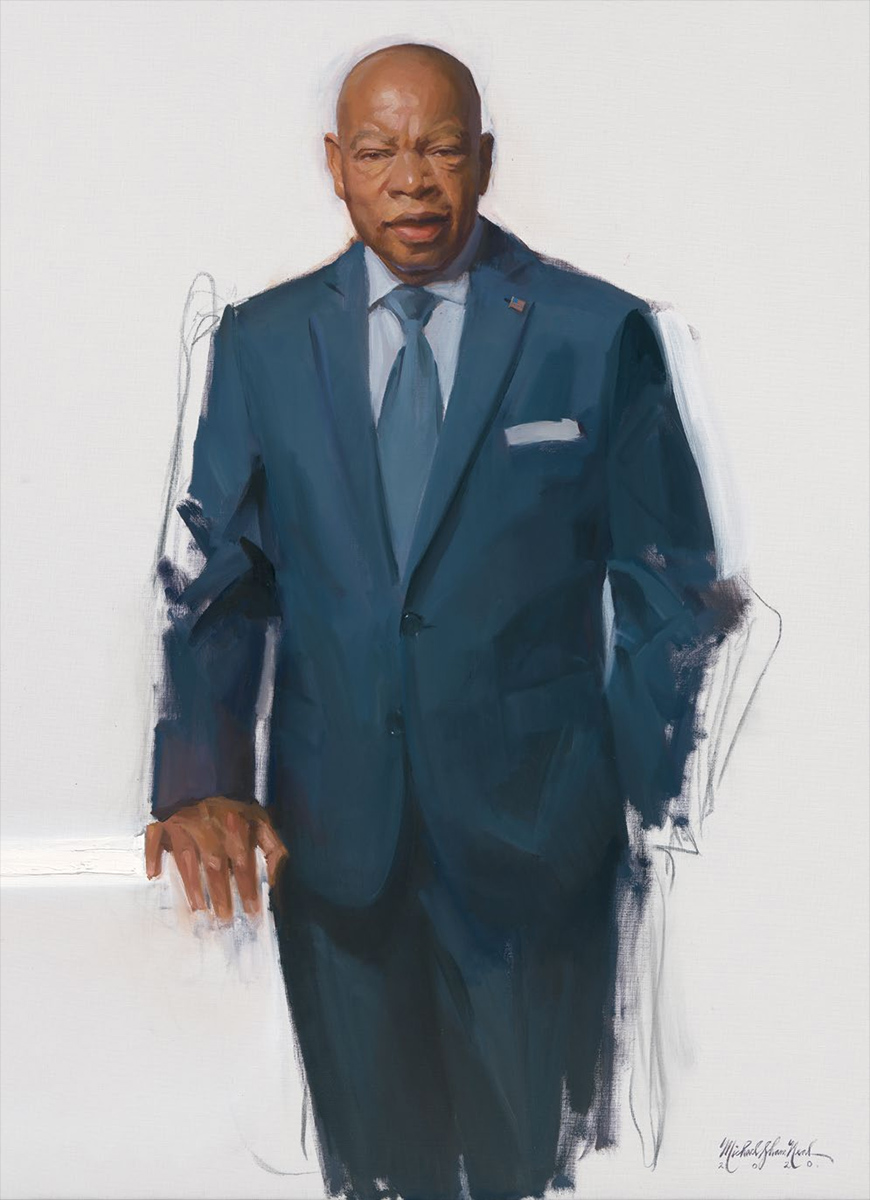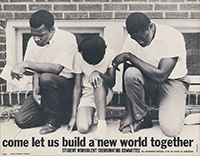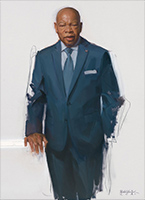John Lewis (1940–2020)

>> Download the Classroom Resource
About the Subject
John Lewis (1940–2020)
was one of the most formidable figures in the civil rights movement. A relentless champion of voting rights and a politician known as “the conscience of the nation,” he demonstrated a desire to affect social change from a young age. Lewis was born to sharecroppers on February 21, 1940, outside of Troy, Alabama, in a rural region known as the Black Belt.1 He grew up on his family’s farm and attended segregated public schools. Lewis graduated from the American Baptist Theological Seminary (now American Baptist College) in Nashville, Tennessee, and later earned a BA in religion and philosophy from Fisk University.2
In 1960, Lewis cofounded the Student Nonviolent Coordinating Committee (SNCC) and organized demonstrations to end racial segregation. He was one of the thirteen original Freedom Riders in 1961; an organizer of the 1963 March on Washington, where he was also the youngest speaker (Martin Luther King Jr. delivered his famous “I Have a Dream” speech at the event); and a key figure in the Selma to Montgomery marches for voting rights in 1965.3 In all his efforts, Lewis consistently emphasized nonviolent, peaceful strategies. Despite more than forty arrests and countless physical attacks (at times resulting in severe injuries), Lewis remained active with the Field Foundation and voter registration programs championed by the Southern Regional Council. He also secured voting rights for millions of Americans through his work with the Voter Education Project.4
During the Carter administration, Lewis headed ACTION (1977–80), a federal volunteer agency, before serving on the Atlanta City Council (1981–85). From there, he mounted his first successful run for Congress. Lewis represented Georgia’s fifth congressional district from 1987 until his death in 2020.5 Throughout his political career, he garnered the respect and admiration of his congressional colleagues as well as countless other Americans, from presidents to everyday citizens. President Barack Obama awarded Lewis the Presidential Medal of Freedom in 2011.6 In 2018, Lewis offered these encouraging words: “Be hopeful, be optimistic. Our struggle is not the struggle of a day, a week, a month, or a year, it is the struggle of a lifetime. Never, ever be afraid to make some noise and get in good trouble, necessary trouble.”7
Please visit https://npg.si.edu/exhibition/john-lewis-1940-2020 for more information and to view additional portraits of John Lewis in the National Portrait Gallery’s collection.
1. “Black Belt,” Encyclopedia Britannica, September 5, 2017, britannica.com.
2. “Congressman John Lewis,” American Civil Liberties Union, accessed April 1, 2022, aclu.org.
3. “Congressman John Lewis,” National Portrait Gallery, Smithsonian Institution, accessed April 1, 2022, npg.si.edu.
4. Ibid.
5. “John R. Lewis,” U.S. House of Representatives, accessed April 1, 2022, history.house.gov.
6. Katherine Q. Seelye, “John Lewis, Towering Figure of Civil Rights Era, Dies at 80,” New York Times, July 17, 2020, nytimes.com.
7. John Lewis (@repjohnlewis),“Do not get lost in a sea . . .” Twitter, June 27, 2018, 11:15 a.m., twitter.com/repjohnlewis.

© Danny Lyon/Magnum Photos
About the Artworks
Come Let Us Build a New World Together by Mark Suckle after Danny Lyon

Advocating nonviolence “not just as a technique, but as a way of life,” Lewis endured repeated beatings and arrests while leading civil rights protests during the 1960s. Danny Lyon photographed him in the summer of 1962, when he initiated a direct-action campaign challenging segregation in Cairo, Illinois. As Lewis (far left) and other demonstrators knelt in prayer during a vigil outside the city’s “whites only” swimming pool, Danny Lyon captured this compelling image.
In 1963, the SNCC issued a poster featuring Lyon’s evocative photograph, along with the appeal to “Come Let Us Build a New World Together.” Priced at a dollar, it was the first in a series of such posters designed to raise funds for the organization’s civil rights initiatives and to carry its message to a wide and largely youthful audience. Offered for sale at rallies and through the SNCC’s newspaper, the Student Voice, the print run of ten thousand posters sold out quickly. Rather than depicting the action of a single individual, the poster’s image celebrates group-centered leadership in which everyone works and struggles together, side by side.
Congressman John Lewis by Michael Shane Neal

In 2016, Michael Shane Neal created his first portrait of Congressman John Lewis. It was commissioned by the Nashville Library Foundation as part of the Nashville Public Library Literary Award given to the congressman for his autobiographic graphic novel trilogy, March. At the award ceremony, Jeffery and Cindy Loring, patrons of the library, were moved to commission Neal to make a larger portrait of the congressman, which they offered to gift to the Portrait Gallery in honor of Lewis’s tireless work and his legacy in the fight for civil rights.
The painting embraces the strength, courage, and resilience of Congressman Lewis and his lifelong work as a civil rights leader. Painted during the final year of his life, this portrait, with the subject’s outline sketched in charcoal and loose, “unfinished” brushwork, evokes the unending struggle for justice that Lewis made his life’s work.
About the Artists
Danny Lyon
“During the 1960s, Danny Lyon used his camera to tell the moving and dramatic story which was occurring in the South.”
– Congressman John Lewis
Driven by his concern for marginalized people and believing in the capacity of photographs to reveal truths, Danny Lyon began his involvement with the civil rights movement in 1962, when he hitchhiked to Cairo, Illinois, during a summer break after his junior year at the University of Chicago. On Lyon’s first day in Cairo, John Lewis delivered a speech at a church that inspired the photographer to follow Lewis and other protesters to a sit-in at a segregated public swimming pool. It was there that he captured the compelling photograph that inspired the “Come Let Us Build a New World Together” poster.
Lyon soon became the first staff photographer for the Student Nonviolent Coordinating Committee (SNCC), which was cofounded by John Lewis. During his time in the South, Lyon documented the SNCC’s direct action and civil rights initiatives; many of his images were used for posters and other materials meant to increase public awareness. Lyon observes, “I had the rare privilege to see history firsthand.”
Of Lyon’s work, the critic John Edwin Mason remarked: “[His] photographs are going to be looked at by historians for as long as people are interested in looking at the history of democracy in America.”
For more about Danny Lyon, visit https://bleakbeauty.com/
Michael Shane Neal
Nashville-based Michael Shane Neal began his career as a portrait painter at age twenty-one. A protégé of Everett Raymond Kinstler, his traditional portraits earned him the First Place and the Grand Prize of the Portrait Society of America’s International Portrait Competition in 2000 and 2001, respectively. Some of his distinguished sitters include Supreme Court Justice Sandra Day O’Connor, President George H. W. Bush, and actor Morgan Freeman.
For more about Michael Shane Neal, visit: https://www.michaelshaneneal.com/
Portrait Observations and Analysis
Come Let Us Build a New World Together
• Describe the setting. What can you glean about it?
• Look at the posture of the sitters. What can we learn from their poses? What are they doing?
• Describe the sitters’ clothing. How does their clothing affect your understanding of the story being told in the image?
• What does the phrase “come let us build a new world together” make you think of? Why would it be included here?
• Why do you think Mark Suckle made this poster? Who was his intended audience?
Congressman John R. Lewis
• Consider the setting (or lack thereof) and the use of color. Why do you think the artist made these choices?
• Describe John Lewis’s pose and facial expression. What do those visual clues say about him?
• What medium, or art material, did the artist, Michael Shane Neal, use to create this portrait? What makes you say that?
• The artist intentionally left the portrait unfinished. Why do you think the artist did so? What indicates the artwork is incomplete?
• If you were to paint a setting for this portrait of John Lewis, what would it be? What objects would you include? What meaning would you assign to the setting and objects?
Compare and Contrast
• Compare and contrast the painting and the poster. How are they similar? How are they different?
• These two works were created fifty-seven years apart. Is the phrase on the poster (1963) applicable to the painting (2020)? Why or why not?
Extensions
• John Lewis was twenty-two years old when Lyon took his photograph. In the painting, he is eighty years old. Consider his accomplishments, identity, and character at both stages of his life. Write a letter from the younger John Lewis to the older John Lewis. Write a response letter from the older John Lewis to the younger John Lewis.
• Using the poster, create a tableaux vivant, or living picture. Recreate the event by assuming the poses and facial expressions of the sitters. Write a short piece of historical fiction from the point of view of the person you portrayed.
• John Lewis became increasingly involved in the civil rights movement when he was a young student. He cofounded the Student Nonviolent Coordinating Committee (SNCC) and organized sit-ins at segregated lunch counters, bus boycotts, and other nonviolent demonstrations. Working in a small group, research one of the ways the SNCC protested segregation. Then, create a poster for change based on your research.
• John Lewis was elected to the U.S. House of Representatives in 1986 and represented Georgia’s fifth district for seventeen terms, totaling thirty-three years! With a partner, research the issues that John Lewis worked on as a congressman. Then, create an election poster for John Lewis based on those issues.
• If you were commissioned to create a portrait of John Lewis, what elements (setting, objects, clothing, etc.) would you include? Make a portrait reflecting your decisions.
• John Lewis was one among many exceptional figures in the civil rights movement. Identify other individuals and research portraits of them as well as their accomplishments. Curate an exhibition of the movement.
• In 2020, to commemorate the fifty-fifth anniversary of the Selma to Montgomery marches, John Lewis said: “Speak up, speak out, get in the way. . . . Get in good trouble, necessary trouble, and help redeem the soul of America.” What did Lewis mean by “good trouble”?
• John Lewis was a staunch advocate for every citizen’s right to vote. On his behalf, write a persuasive piece on the importance of exercising the right to vote.